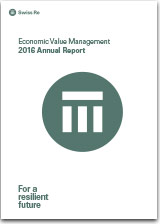Economic Value Management
EVM is an integrated economic accounting and steering framework based on market-consistent valuations and defines the method for measuring value creation for all business activities of Swiss Re.
Economic Value Management (EVM) is Swiss Re’s integrated economic valuation framework for planning, pricing, reserving and steering the business. Since 2003, Swiss Re has used the EVM framework as a tool to support business and strategic financial decisions, including compensation. EVM also provides the basis for determining available capital under the SST and Solvency II.
The key EVM valuation principles are summarised below.
Market-consistent valuations
All traded assets and liabilities are marked to market, based on quoted prices in active markets or observable inputs. Assets and liabilities that are not traded are valued consistently with market prices. The Group’s insurance liabilities are valued on a market-consistent basis by replicating future expected cash flows with liquid financial market instruments. As the majority of the Group’s insurance liabilities do not contain embedded financial market risk exposure other than to interest rates, the market-consistent value can be determined by discounting future cash flows using prevailing risk-free interest rates. If insurance liabilities include embedded options or guarantees (eg, variable annuities or interest-rate-sensitive life business), they are valued on a market-consistent basis using stochastic models and other appropriate valuation techniques.
Performance split of underwriting and investment activities
EVM values insurance underwriting and investment activities separately. Underwriting activities create value by raising funds in insurance markets at a lower cost than through other sources. The investment functions are assessed on a risk-adjusted basis. This makes possible a like-for-like comparison of underwriting and investment activities.
Closed-book approach
EVM recognises all cash flows associated with a new contract at inception, and any changes in estimates as they occur. In comparison, the deferral and matching principle under US GAAP postpones recognition of revenues until they are earned and matches expenses to those revenues. EVM excludes the recognition of all potential future new business activities, as well as potential renewals.
Best estimates
Swiss Re values assets and liabilities based on best estimates of underlying cash flows — premiums, claims, expenses, taxes, capital costs, etc — taking into consideration all the information available at inception of a contract. As with other valuation methods that depend on projections of future cash flows, EVM involves a significant degree of judgement in establishing what assumptions should be used. Swiss Re actively and carefully reviews its assumptions, seeking both to achieve consistency across business activities and to reflect all available information.
Performance measurement after capital costs
EVM explicitly recognises opportunity costs for shareholder capital. Cost-of-capital charges include the base cost of capital and frictional capital costs. The base cost of capital is reflected through a charge for risk-free returns on available capital and market risk premiums. Market risk premiums compensate for systematic, non-diversifiable risk exposure, mainly assumed through investing activities. Frictional capital costs compensate for agency costs, costs of potential financial distress and regulatory (illiquidity) costs; they are reflected through a 4.5% charge on available capital and an average 2% charge on leverage.

EVM results for 2016
The 2016 EVM Report, showing Swiss Re’s results for the full year 2016, is available on swissre.com/investors/financial_information
Economic net worth in 2016
Economic net worth (ENW) is defined as the difference between the market Value of assets and the market-consistent value of liabilities. ENW is the EVM measure of shareholders’ equity and the starting point in determining available capital for SST calculations.
In 2016, ENW decreased by USD 0.8 billion to USD 36.6 billion at the end of December 2016. 2016 total contribution to ENW of USD 4.2 billion was more than offset by the Swiss Re Ltd’s dividend payments, the share buy-back programme and a change in the EVM methodology.
Economic net worth
| Download |
|
USD billions |
2015 |
2016 |
Change in % |
|
Property & Casualty |
16.1 |
14.2 |
–12 |
|
Life & Health |
10.2 |
10.8 |
6 |
|
Reinsurance |
26.3 |
25.0 |
–5 |
|
Corporate Solutions |
3.0 |
2.8 |
–7 |
|
Life Capital |
3.6 |
3.8 |
6 |
|
Group items |
4.5 |
5.0 |
11 |
|
Total |
37.4 |
36.6 |
–2 |